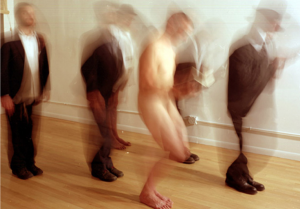
It says in Bereishis: “Male and female [Elokim] created them, and [Elokim] blessed them and called them Adam on the day they were created” (5:2). There is something profoundly disorienting about this verse, something that would escape notice with a cursory or unrefined reading of Genesis, something that might remain illegible. However, for the second-century scholar R’ Yirmiyah ben Elazar, the verse’s contradictory movements between plural and singular — Elokim created them, but called them Adam — suggested a rather simple interpretation of human creation: “at the moment that the Holy One blessed be He created the first Adam, as androginus [Elokim] created him” (Bereishis Rabbah 8:1). And that is all the rabbi has to say, as if it is enough. The possibility that the primordial Adam was androgynous was not unthinkable to him — and it was certainly not transgressive.
We are living through a moment that is anything but normal. As the modus operandi of confinement rippled unevenly across the globe, the mundane norms that quietly structure our lives dissolved nearly overnight. Even as dysfunctional and pernicious governance exacerbates systemic inequities and establishes new ones, the school day and the work week, rush hour and the weekend, the street and the sidewalk, the beaches and parks — all of which mark a certain temporal and spatial order — have vanished.
What remains? When we can no longer regulate our lives according to the dominant fictions, where do we turn? It is in response to such a question that our exploration of rabbinic, Talmudic, and otherwise Jewish approaches to (what we call) gender, sex, and sexuality gains unexpected potency. The interregnum induced by a pandemic might make the small rips in our social fabric a bit larger. As we pause and reorient, not only do new horizons become more visible but also what had always escaped the dominant fictions, and resisted inclusion in them, becomes more legible.
This issue of PROTOCOLS begins from the assumption that the six categories outlined in the Talmud — zachar, n’keva, androginus, saris, aylonis, and tumtum — reflect ambivalent and provocative ways rabbinic culture and thought can intervene in contemporary and historical schemes of gender, sex, and sexuality. At the same time, we do not approach the six categories as simply a curiosity or relic of rabbinic text to be mined and revived. The categories themselves signal how Jews historically perform, ritualize, and self-fashion gender in ways that confront, withdraw from, articulate, and perhaps submit to rival orders.
Some of the contributions to this issue include: curator and editor Noam Parness’ meditation on Rosemary Mayer’s sculptural representations of divinity; Yosefa Raz’s original series of poems, “This Rumor of Darger’s Armies of Girls,” accompanied by original watercolors from Inbal Mendes-Flohr; Michal B. Ron’s visit to artist Moran Sanderovich’s studio, a sea of fabulous, grotesque bodies and semi-organic objects; Tobaron Waxman’s net-artworks animate trans and Jewish languages of embodiment in interactive ways; and Ashley J. Bohrer, in “Radical Pleasures and Radical Critique,” interrogates the pleasures of discovering a “queer Talmud,” suggesting a more critical stance toward desires for inclusion. The contributions in this issue are also indebted to three guest editors: writer and curator Ariel Goldberg, artist Roey Victoria Heifetz, and scholar Hannah Tzuberi.
Enjoy!